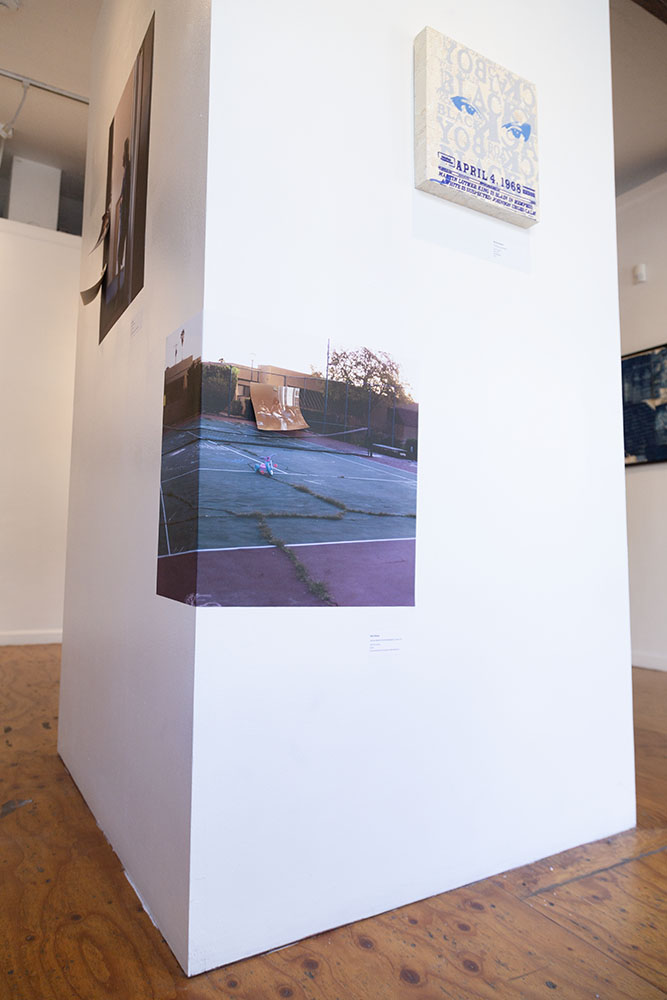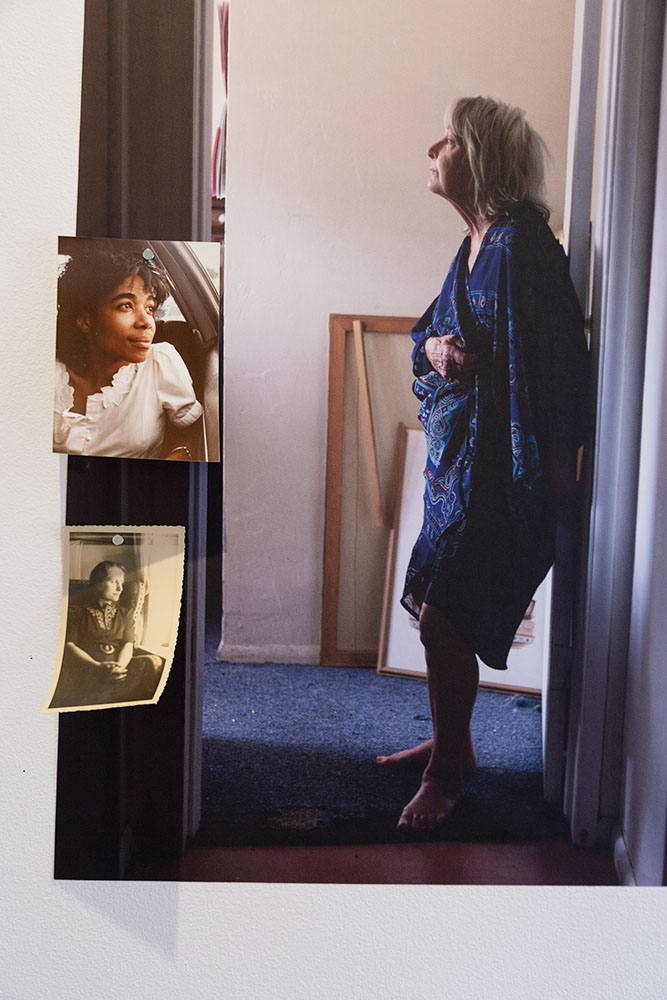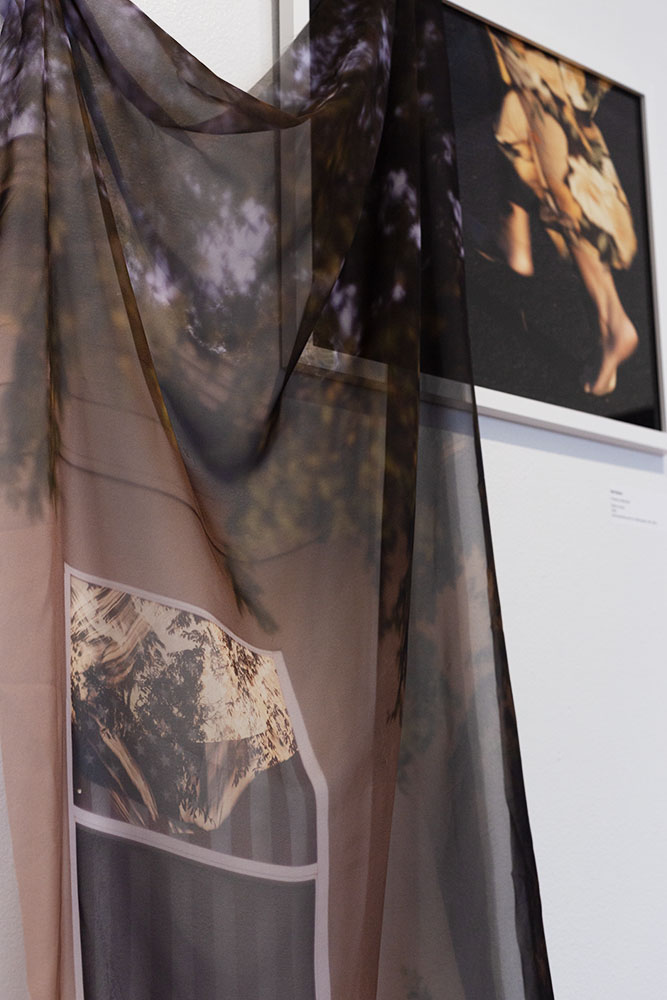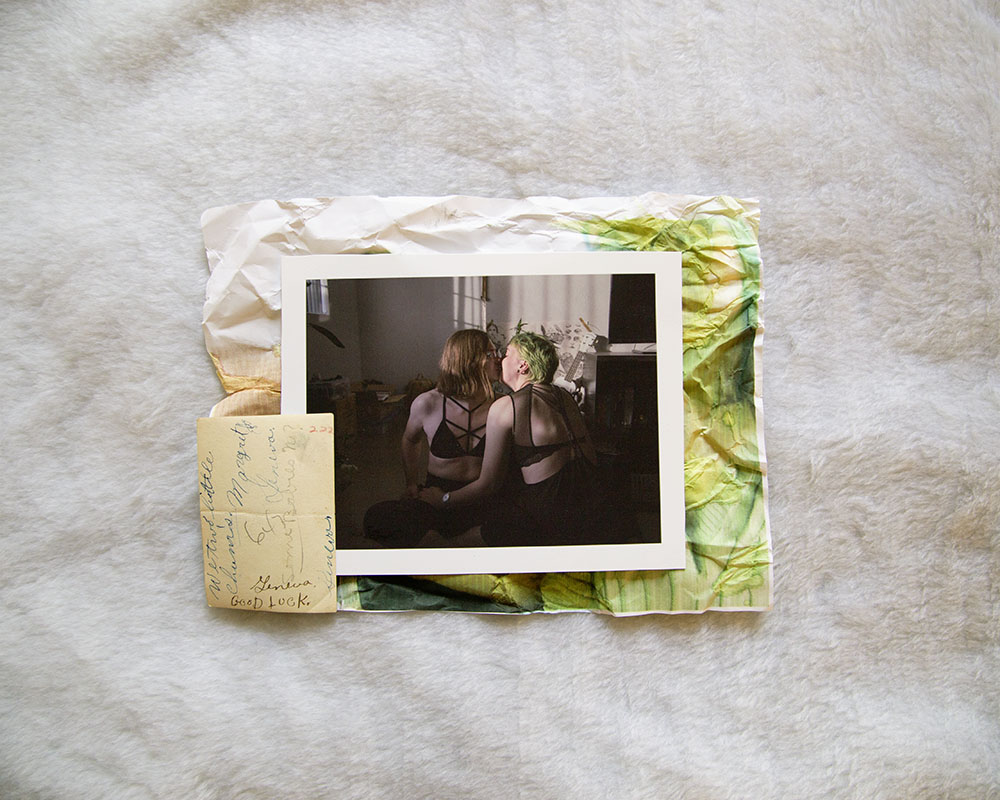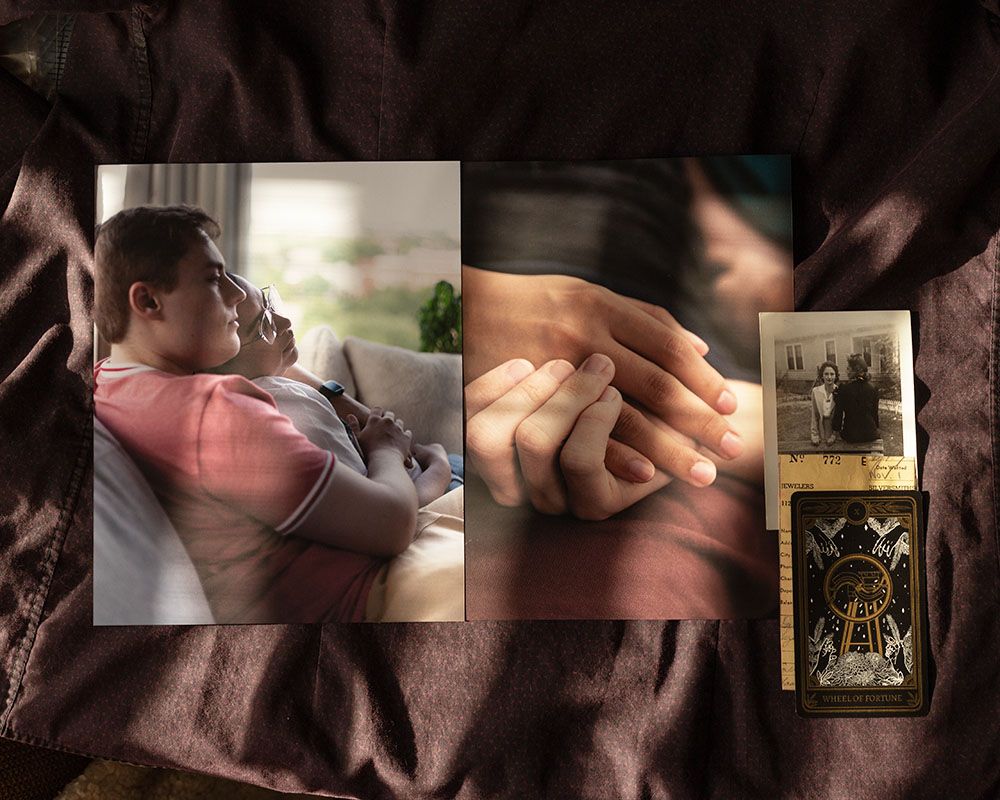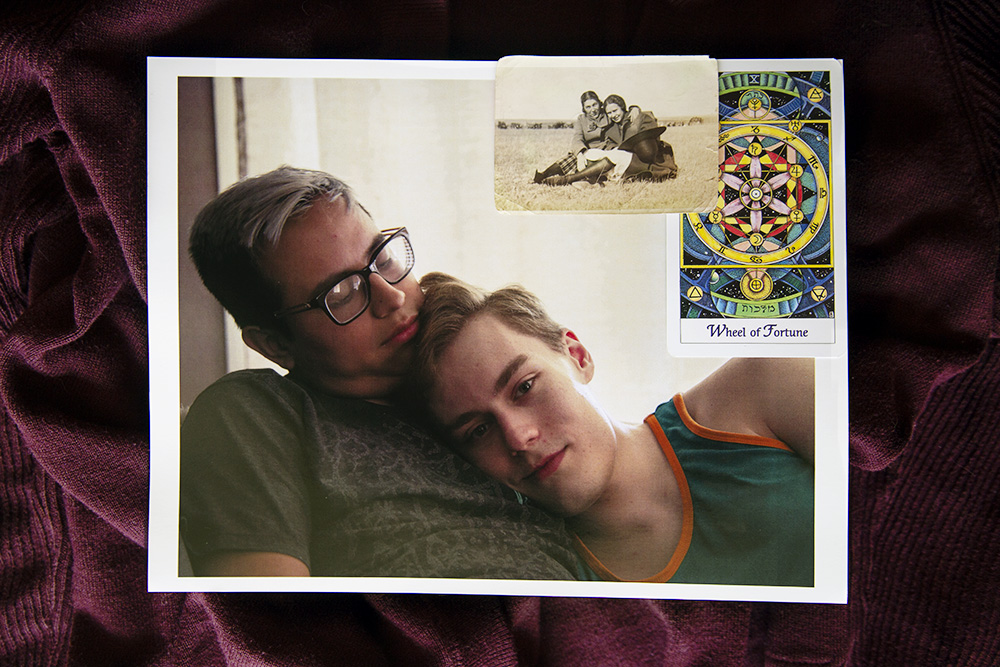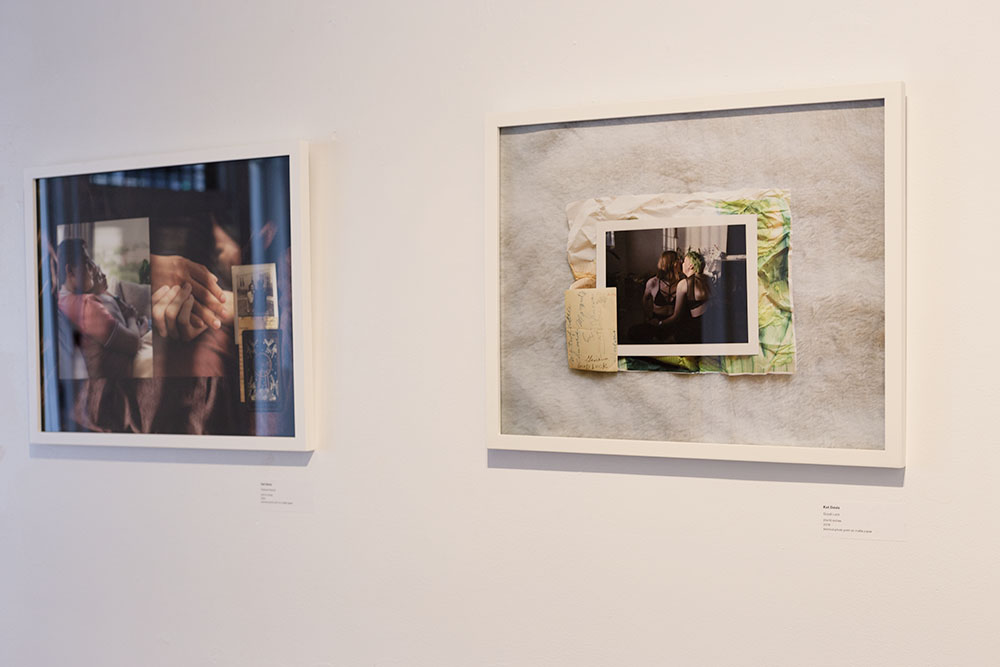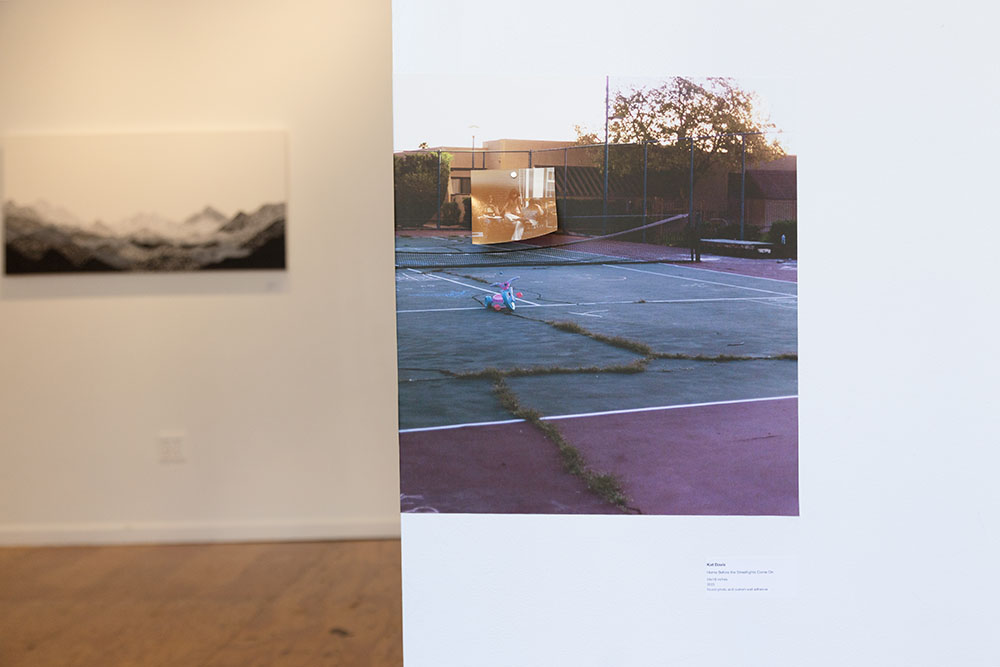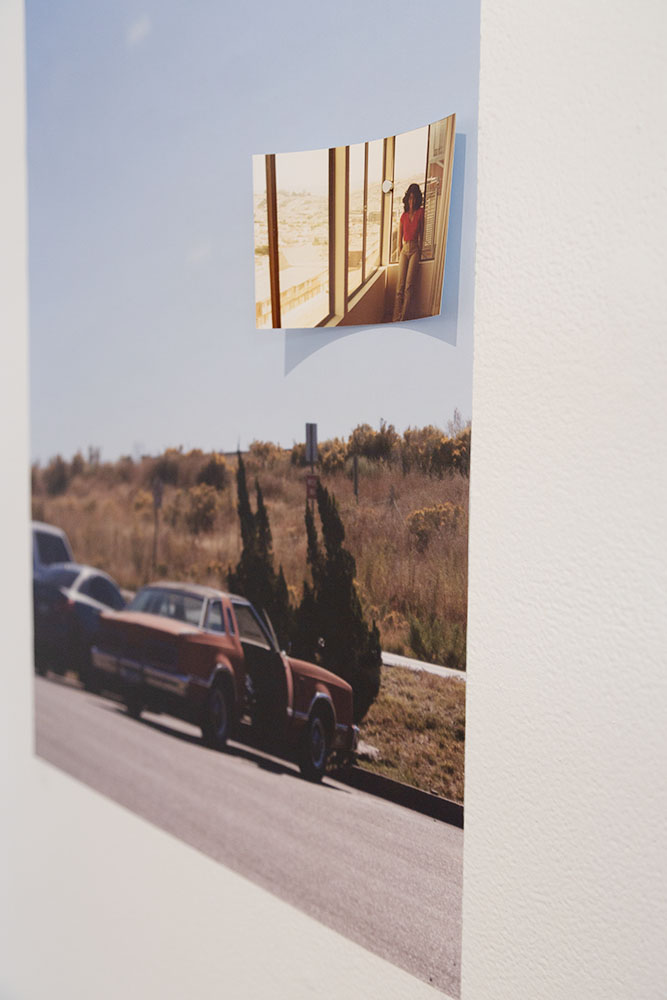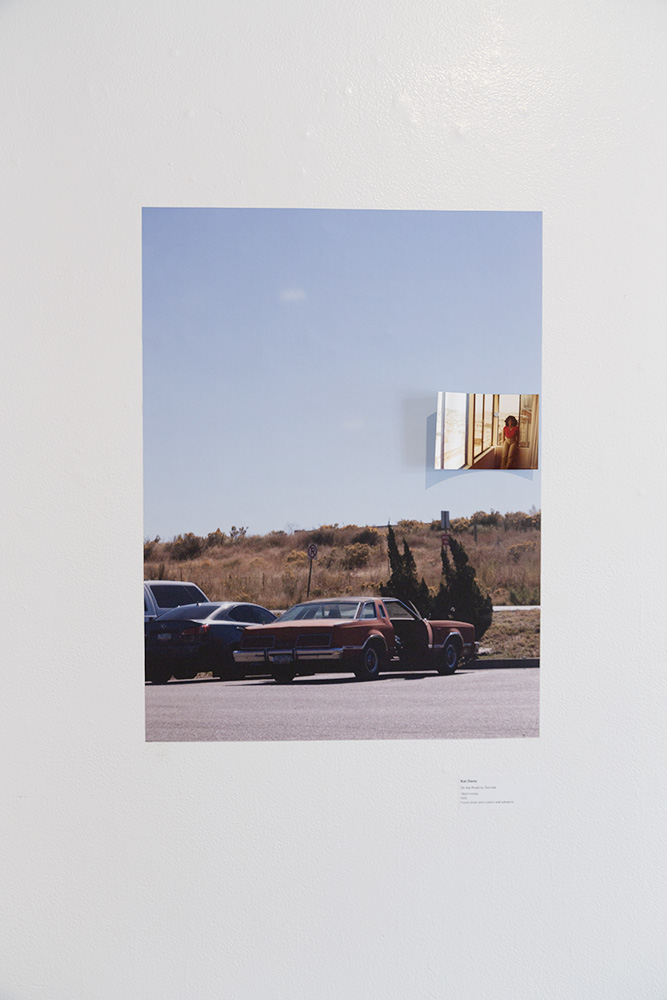Intimations on Kat Davis’ Excerpts
After pawing through an antique store, Goodwill, or secondhand shop of any kind, you’re soon to feel the grime of aged objects cling to your hands. Potentially decades of dust nestle in your fingerprints and under your nails, and your mind hyperfixates on every inch of skin until your own clothes become unbearable. After spending hours scraping through tins of displaced photographs, when you’re scraping at the few resigned on a bed of detritus, you resent the entire excavation. Certainly, I do. But with an archaeologist’s determination, artist Kat Davis is loathe to leave any photograph unturned, unexamined, and left to dust.
Central to Kat’s work over the past several years is the use of what I’m calling the Thrifted Subject. The Phoenix-based artist’s affinity for found photos and other ephemera warps the historicity of both the found photo and its new home among Kat’s own photographs and assemblages. Having excerpted their work for the group exhibition, Like Dust, Kat pulls from several bodies of work–and numberless family albums–to continue their play with the fragility of context.
Pillow Talk
Before diving deeper, I must disclose that I am not a passive observer of this work. As Kat’s partner and spouse, I’ve seen them at work. I’ve rummaged through antique stores beside them, served as an imbalance tripod (bipod?), and sat as one would at a tarot reading as Kat shuffled together and spread out their portraits, thrifted photographs, ephemera, and, yes, tarot cards. But this is not to say that I am writing as the artist’s spouse; it is not my intimacy with Kat that has inspired this essay, but my intimacy with the work. I’ve been initiated into something arcane, watching intently as Kat manipulates moments to create new histories.
Launching into an essay on work I know so intimately has been more challenging than anticipated. Being the writer in our home, I’ve helped Kat write up traditional artist statements for their projects. I’ve even helped with the blurb for Like Dust, but now the work is on the walls. The statement is made. Which means this text has to be something different. It is a third iteration/translation of the subject, now coming from my voice directly. I’m shy–and maybe a little jealous–sharing what the work has intimated to me throughout its conception (pillow talk), and having to use feeble words. (I already find the exercise of an artist’s statement superfluous–what then, is the true point of this text?)
An Abundance of Possibilities
For the past several years, Kat has scoured through antique stores, dusty bins, Etsy shops, and cardboard boxes looking for fragile, orphaned moments, for those who would fit into new homes. “The discarded, misplaced, and displaced photographs I find may not have notes or names but do have an abundance of possibility,” the show’s statement reads. “The intention behind the work is to recontextualize moments, to remove their dust and place them back into stories, and as a result, show the commonality of experience across time and place.”
Kat has characterized themself as a sort of archivist, preserving domestic moments. As they preserve these moments, they restage them. In the earlier How We Were, and Other Possibilities project, found photographs of anonymous same-sex couples (and we use “couples” here in the most general sense, as the relationship between the people in the photographs are just as lost as their names) were placed among photographs Kat has taken of people known to be queer–and capable of sharing it in a place in history more understanding of the queer experience. In doing so, the original photographs get to bring that understanding and acceptance back into their own moment. History gets to be rewritten. Kat and their viewers get to play with possibilities.
Later, Kat revisited this form of play in the show, Untraditionally American, which was developed in partnership with painter Brianna Noble. The first work excerpted in Like Dust was exhibited then, taking on a more domestic tone than How We Were, even as the domicile may be undeclared. As you look through the work, you feel like a bird looking for a place to nest. The idea of searching for one’s place unfolds in Kat’s act of assemblage, as old photographs find their new place decades away from where they were. The idea of nesting out of one’s time also plays into another theme of Untraditionally American: the American Dream fading from memory–or better yet, fading from one’s imagination. Both Kat and Brianna are investigating these themes as Black artists, which forces us to reconsider the American Dream as not just unattainable today, but out of reach even at the time the old photographs were taken. The people Kat has launched decades forward into the present don’t find the same comfort as those transported through How We Were. But now Kat can commiserate with them, as we struggle to find our own nest in an inhospitable housing market (will someone carry our dusty photographs into a post-feudalist future?).
Like Dust
Home remains ever distant in these Excerpts. Like Dust presented Kat an opportunity to revisit and refine what was first exhibited in Untraditionally American, and they rehoused a couple of pieces from How We Were…, as well. Through seven works (eight if you separate Flashpoint, presented as a tapestry, from I Know a Shortcut, over which the former is draped), Kat demonstrates how quickly nostalgia can deteriorate when gripped too tightly.
Because of a disdain for glass and frames, several of Kat’s pieces were printed on vinyl and adhered directly onto the gallery walls. This aligns with their efforts to liberate characters and moments from their narratives (you can’t play with a dollhouse that has all four walls). The thrifted photos are layered over these adhesives, suspended by tiny, movable magnets. Though I know this method of installation to be one of prudent practicality, it falls in the worthy tradition of the home gallery (i.e. the refrigerator) giving the found photos the same sort of charming lack of context they’d find in our own homes, or the ones from which they were separated by way of estate sale.
I Know a Shortcut presents us with bare feet dashing over the asphalt, rushing the subject to a hiding place in Flashpoint. The latter, depicting a typical suburban home with an American flag encased in a window, captures the moment when the reflected sunset gives the illusion of the flag on fire. If only we could warn the subject taking the shortcut just how fragile their hiding place is! The bare feet at once remind us of the uncaring play of children running in the street, as well as the vulnerability of a person who has no time to put on shoes.
Flashpoint’s fire is, in turn, reflected in Brick by Brick, where a photograph of a different suburban home is actively burning on a pile of dirt. The white brick house is paired with an old photo of someone making use of a brick oven or fireplace. What’s been left burning throughout the decades? What will be left to smolder?
As renters of a second-story apartment, Kat took this photo on our balcony, using a mix of potting soil and the dust that just accumulates everywhere in Arizona. I was nervous about the breeze carrying the embers to the dead leaves piling up in the corner or their parent tree encroaching on our patio furniture. Here the fragility of context includes also the context within which these photographs were taken, and indeed, the spatial context of the artist themself.
Good Luck and Fortune’s Favor were both originally featured in Kat’s How We Were. They chose to keep Good Luck as it was first presented–a simple rehousing of the piece–but Fortune’s Favor was transformed. Originally titled, Fortune (shown below), the work featured the same friends of ours, though several years in the past, paired with a different thrifted photograph, and adorned with another variant of the Wheel of Fortune Tarot card:
Though placed in the bottom corner of the frame, the Wheel’s axle is the fulcrum of the entire body of work. The Wheel keeps on turning, and we are reminded of ideas like the eternal recurrence, time is a flat circle, etc. and the card’s placement in this work is not without irony. Through their work, Kat scoffs at fatalism. Moments are unstable, time is mutable–at least, that’s the hope. Whether Kat’s displacement of moments interrupts the patterns they left behind is left unanswered. We only see the moments where they are placed, now.
An Initiation
Time is fragile, space is fragile, and therefore, context is fragile. That is the essential formula of Kat Davis’s work (consider yourself initiated). Kat’s recontextualization of thrifted photographs is a form of play as much as it is an arcane act. The artist is destabilizing several moments: that of their subjects (both natural and adopted) as well as that of the viewer. The thrifted subject is ripped from their place in history in an obvious way, but we are also reminded that the contemporary subject–Kat’s friends, mother, and Kat themself–is also ripped from their moment. The distance is shorter, yes, but as viewers, we are always looking backward through time–let’s not forget we are complicit in this act. And our moments are receding in time as well, fading in memory, and losing their present context. In How We Were, Kat instructed us on how liberating that can be, and what possibilities we can make of it. In Excerpts, Kat gives the caveat–the warning–that we are also prone to false nostalgia, and we should be careful in which moments we try to nest.
Kat Davis uses the medium of photography to explore presentation and performance of individual identity and its relation to social and political boundaries. The addition of found photos and objects adds a new dimension by which Davis can bend the arrow of time to create new histories. The original photographs get to bring new understanding and acceptance back into their own remote moment. History gets to be rewritten.
Davis earned their BFA in Photography from Arizona State University in 2017. Their images have been exhibited nationally at Specto Art Space, Grand Arthaus, Vision Gallery, Modified Arts, Eye Lounge, Northlight Gallery, and have been published in Cumulus Photo, Soft Lightning, OURS Photo Mag and here, at Lenscratch.
Instagram: @kat___davis
Brett Bezio is a Phoenix-based writer with a passion for bending genres. They delight in crafting personal and lyrical essays that explore the intersections of art, critical theory, and personal experience. Their writing offers a unique perspective on art criticism, blending academic rigor with a deeply personal touch.
Posts on Lenscratch may not be reproduced without the permission of the Lenscratch staff and the photographer.
Recommended
-
Salua Ares: Absense as FormNovember 29th, 2025
-
Ricardo Miguel Hernández: When the memory turns to dust and Beyond PainNovember 28th, 2025
-
Pamela Landau Connolly: Columbus DriveNovember 26th, 2025
-
KELIY ANDERSON-STALEY: Wilderness No longer at the Edge of ThingsNovember 19th, 2025
-
Jackie Mulder: Thought TrailsNovember 18th, 2025



